Dr Stevenson’s Northern Tour 1927
And bowling from the Lover’s Loan end … Harold Larwood
RS Clark – a true Carlton hero
Sydney Barnes: The greatest ever Carlton bowler?
When the Aussie skipper lost three teeth to a Carlton legend
The day Carlton CC faced Heart of Midlothian FC
The tragic tale of John MacFarlane
Carlton’s Olympian All-rounder
The Grand Fancy Fair & Carnival 1912
Dr N L Stevenson’s Northern Tour
We were delighted to hear from a grandson of the legendary Dr N L Stevenson, Charles Patmore, who got in touch to forward a pdf copy of a book he had in his possession. The book, ‘Dr N L Stevenson’s Northern Tour’, was published in 1927 and recounted the tale of a group of Carlton players and friends who toured the north of Scotland in early September led by ‘NLS’.
Charles takes up the story of the book:
‘Dr N.L. Stevenson’s Northern Tour 1927’ is a very slim hardback which tells a cheery tale of Carlton Club stalwarts on a cricketing jaunt in Perthshire in September 1927.
One of this book’s attractions for me is that my grandfather, Norman Lang Stevenson, and two of my uncles are among at least six Carlton Club members who play in these 1927 matches. Another is the rather charming period tone of the story – the picnic, the evening party games and photos of some bewildering ladies’ hats.
In some photos, there’s a cross marked beside one person. I am reasonably sure that this must be Jack Traill, the Club’s Secretary at the time, for it was his widow who gave us this book. I would guess that Jack Traill may have been the anonymous author.
In some photos, like the charabanc photo at the beginning, Norman Lang Stevenson can be quickly identified by his Highland bonnet – always an ardent Scottish patriot!”
And bowling from the Lover’s Loan end … Harold Larwood
England’s finest ever fast bowler at Grange Loan? It so very nearly happened …
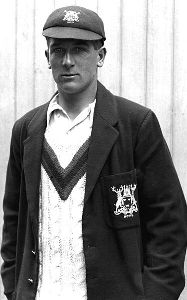 In 1933, Harold Larwood was the most famous sportsman in the UK. His bowling heroics in the infamous Bodyline Ashes series of 1932/33, under the captaincy of Douglas Jardine, meant that he was a household name from London to Aberdeen.
In 1933, Harold Larwood was the most famous sportsman in the UK. His bowling heroics in the infamous Bodyline Ashes series of 1932/33, under the captaincy of Douglas Jardine, meant that he was a household name from London to Aberdeen.
During what turned out to be the most famous Ashes series in history, Larwood (left) found himself headlining on the back and front pages of newspapers on both sides of the world. While England won the series 4-1, thanks in large part to Larwood’s 33 wickets at less than 20, Jardine’s tactics of getting his bowlers to fire short pitched deliveries onto the bodies of the Australian batsmen, supported by a packed legside field, had won the skipper – and his premier bowler – few friends Down Under. Indeed Larwood had been responsible for hitting both the Australian skipper Bill Woodfull and his colleague Bert Oldfield with fearful blows, although he maintained that he hadn’t been bowling ‘Bodyline’ at the time.
While the battle for the Ashes was being fought out in Australia, Carlton skipper Dr N L Stevenson had been working on a new idea – organising a group of Scottish cricketers to come together regularly to play matches to raise money for player benefits and for charity. The team was named The Crustaceans – in homage to their President, Major H J Stevenson, who had once been a leading ‘lobster’ (i.e. under-arm) bowler. The first match was arranged for Grange Loan in the summer of 1933 and Stevenson knew that there was one player above all others that the Edinburgh cricketing public would pay good money to see – Harold Larwood.
Stevenson takes up the story in his book ‘Play!’:
“Up to this point everything had gone without a hitch, and to inaugurate the new Club’s playing career a special opening game was arranged, between the strongest XI that could be selected in Scotland (not a single player who was asked refused) aided by Larwood, fresh from his Test-match triumphs in Australia, and a very strong representative team of Scottish professionals, selected by R. A. Haywood, the Fettes College “coach”.
Larwood’s foot, it will be recalled, gave him a lot of trouble on the “cast-iron” wickets of Australia; but when I was in correspondence with him, he had no reason to suppose that he would be unable to play. In point of fact, after fixing a convenient day for the match, Larwood wrote and told me he would travel to Edinburgh by the “Scotch Express” from St Pancras on the Tuesday night, bringing Mrs Larwood with him. A day or two later, having seen somewhere that Larwood was having fresh trouble with his foot, I wired him and received the answer –
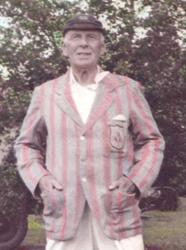
“Am coming definitely – Larwood”.
Meanwhile, Grange Loan had been prepared for the big occasion, with a grand-stand and seating accommodation for 2000 spectators. The printing and advertising had been carried out, too, when the blow fell. Larwood had to write and tell me that two small bones in his left foot were now believed to be broken, and so, while still willing to come to Edinburgh as arranged, he could be counted upon only as a batsman.
Larwood is a fine batsman. He has made 98 in a Test match against Australia. But I knew the Edinburgh cricket-loving public wanted to see him bowl – indeed, expected to see him bowl – and, consequently, I considered it would not be polite to bring him North under more or less false pretences.
With great reluctance, and at a considerable financial loss, we had to cancel the match.”
While Larwood did play cricket again, he was never the same bowler thanks to a combination of his injured feet and his shabby treatment by the English cricket establishment as they sought to distance themselves from the Bodyline fall-out. And, sadly, Harold never did make it to Grange Loan.
Robert Clark: a true Carlton hero
In his book Play!, a history of Carlton from its inception until the Second World War, long time club skipper Dr N.L. Stevenson, recorded the arrival at Carlton of a young graduate from Aberdeen University: “R.S. Clark came to us from Aberdeenshire with a great cricket reputation. He was a beautiful bat, using his wrists to full advantage in making a panoply of classic strokes.”
But it was not the quality of his batting that made Clark a celebrity during the early part of the Twentieth Century; rather it was his role in one of the most remarkable survival stories of all time …
 Robert Selbie Clark, a graduate of Aberdeen University, arrived in Edinburgh in 1911 to take up a position as zoologist at the Scottish Oceanographical Laboratory. Like so many discerning ‘incomers’ to the city before and since, Clark found his cricketing home at Grange Loan. His on-field impact was immediate and he made his Scotland debut in 1912 against Ireland in Dublin.
Robert Selbie Clark, a graduate of Aberdeen University, arrived in Edinburgh in 1911 to take up a position as zoologist at the Scottish Oceanographical Laboratory. Like so many discerning ‘incomers’ to the city before and since, Clark found his cricketing home at Grange Loan. His on-field impact was immediate and he made his Scotland debut in 1912 against Ireland in Dublin.
Clark’s Carlton career was interrupted the following year when he took up the post of naturalist in charge of fishery investigations at the Plymouth Marine Biological Association. At the same time, legendary Antarctic explorer Sir Ernest Shackleton was planning a hugely ambitious expedition from Plymouth. Shackleton’s aim was to cross the continent from sea to sea, via the pole. In 1914 Shackleton invited Clark to join the expedition as biologist – an offer that the batsman at first refused. However, legend has it that a last minute change of heart saw Clark jump onto the Endurance from the pierhead just half an hour before the ship departed.
Even then he appears to have remained in two minds, writing in his diary not long after departure: “I cannot think what I am doing here and shall certainly return from Buenos Aries.” Before long though, Clark was committed to the cause and quickly turned his energies to logging observations and collecting specimens. He was apparently fascinated by the icy seas and landscapes and, as the Endurance made its way through the polar ice pack, he and his shipmates took delight in interpreting the ‘Claak Claak’ of the penguins as a sign that the penguins were calling out to the Carlton man.
As the Endurance sailed further into the Weddell Sea, the conditions became steadily worse and by early 1915, the ship had become completely trapped in an ice floe. Shackleton quickly realised that there would be no escape until spring and the crew set to work to turn the ship into an ice station. Clark and his colleague took possession of a temporary cubicle, which they set up as their living quarters, christening it “Auld Reekie”.
 Despite their predicament, Clark assiduously continued his biological work. At one point a colleague reported hearing a great yell from the ice floe and found Clark “dancing about and shouting Scottish war-cries. He had secured his first complete specimen of an Antarctic fish, apparently a new species.”
Despite their predicament, Clark assiduously continued his biological work. At one point a colleague reported hearing a great yell from the ice floe and found Clark “dancing about and shouting Scottish war-cries. He had secured his first complete specimen of an Antarctic fish, apparently a new species.”
By September of 1915, the moving and breaking of ice caused by the arrival of Spring began to exert great pressure on the ship’s hull and, on 24th October, the water began to pour in. Shackleton soon had no option but to order the abandonment of the Endurance and the men set up camp on a nearby ice floe. On 21st November the wreck finally disappeared below the surface (right), taking all Clark’s collections and records to the bottom of the ocean.
Despite being apparently perceived as the archetypal dour Scotsman, Clark was a popular colleague and his calm outlook helped to steady morale in the hard months spent on the ice. For four months Shackleton and his group hoped that the ice floe would drift in the direction of land. However, when the floe finally broke in two in April of 1916, Shackleton ordered the crew into lifeboats to head for the nearest land. After five days the three boats reached Elephant Island, an inhospitable icebound isle almost 600 miles south of the Falkland Islands.
Marooned far from the nearest shipping lane, Shackleton calculated that the only hope of survival was to take one of the open boats to the South Georgia whaling stations, almost 800 miles away, to summon help. Clark was left on Elephant Island with 21 of his shipmates and the remaining two boats were turned upside down to create a hut. According to a later report Clark “was allotted a berth in the “attic” between the thwarts and the boat bottom which required him to stow his long body horizontally, and where he was compelled to sleep, read and eat in the same position.” He apparently turned out to be something of a creative cook, making best use of the staple diet of penguins, seals, limpets and seaweed.
Miraculously, Shackleton reached help after a two week sea journey and a 36 hour trek on foot across South Georgia. For Clark and his colleagues, rescue was still a long way away though and it was only after three failed attempts to break through the ice fields that Shackleton finally reached Elephant Island on 30th August of 1916.
Following his rescue, Clark became an officer in the Royal Naval Volunteer Reserve, serving his time on minesweeping duties. After the end of the war, he returned to the Marine Biological Laboratory at Plymouth before heading back to his native Aberdeenshire to become the senior naturalist at the Marine Research Laboratory at Torry.
Despite working in Aberdeen, Clark’s feelings for Carlton clearly remained very strong and he regularly made the journey south to play for the club. In 1922 he finished third in the club’s batting averages and, two years later, he was a member of the Carlton side that went through the 1924 season undefeated. That year Clark made three further appearances for Scotland, scoring 29 against the touring South Africans.

Dr Stevenson was always keen to attract top players to Grange Loan for matches that would draw big crowds (and therefore boost income) and in 1924, following the appearance of Sydney Barnes for Carlton in 1922 and 1923, he tempted Australian test bowler EA (Ted) McDonald, who had taken 27 wickets at 24 in the Ashes series in England just three years before, to turn out for Carlton in a match against J.W.H.T. Douglas’s Essex XI. A pre-match photograph (below) shows Stevenson standing in front of the old Grange Loan pavilion, flanked by his two celebrity team-mates: the great fast bowler on his right and the Antarctic hero on his left.
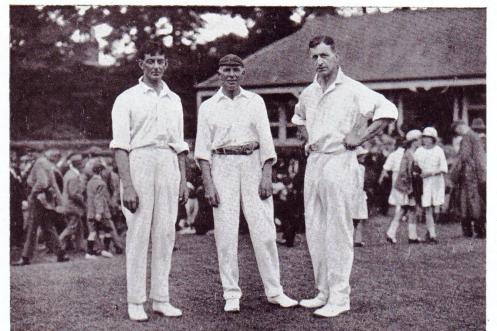
In 1925 Clark gained a D.Sc. (Doctor of Science) and took over as director of the Fisheries Research Laboratory in Aberdeen. He retired in 1948 and died two years later at the age of 68.
While Robert Selbie Clark will always be renowned for his part in one of the greatest ever polar adventures, it was his batting that moved his Carlton skipper to deliver a glowing verdict:
“On his day he gave the impression of being a super-batsman, so effortless was his play, which even to-day is spoken of with admiration from Mannofield to the playing fields of far-off Devon, where as an opening batsman he scored several centuries and, in at least one season, headed the Devon county batting averages. In my time the Club has had few better recruits than Dr R.S. Clark.”
Sydney Barnes: The greatest ever Carlton bowler?
One of the greatest ever English Ashes heroes was a Carlton bowler, who took 106 Australian Test wickets at an average of just 21.58. Are we stretching the truth a little? Judge for yourself by reading the following article, which first appeared in the 2010 Carlton match programme.
So who is the finest bowler ever to play for Carlton? While there have been many candidates over the years, there is one cricketing giant who has a greater claim to this title than any others.
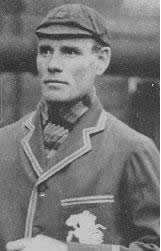 In 1922, club captain Dr N.L. Stevenson invited a very special cricketer to turn out for Carlton. He takes up the story in his book about the early years of the club, ‘Play!’…
In 1922, club captain Dr N.L. Stevenson invited a very special cricketer to turn out for Carlton. He takes up the story in his book about the early years of the club, ‘Play!’…
“The big event of that season, which marked the Carlton Cricket Club’s Diamond Jubilee, was a specially arranged two-days match in which S.F. Barnes, the famous England bowler, appeared in the Carlton side.
Of Sidney [sic] Barnes a whole book could be written. The mention of his name will suffice for those whose cricket recollections ante-date the first world war. For the younger generation let me quote what Sir P.F. Warner once wrote:-
‘The Australians have always maintained that Barnes is the greatest bowler we have ever sent them. It may certainly be maintained that he has never had a superior, and very few equals. He was the best bowler on all wickets that I have met, having every good quality – spin, break both ways, flight, and accuracy.’ ”
If any young readers are not too sure of the cricketing pedigree of Barnes (left), it’s worth pointing out that he is rated the best ever test bowler in the Reliance Mobile Test Rankings.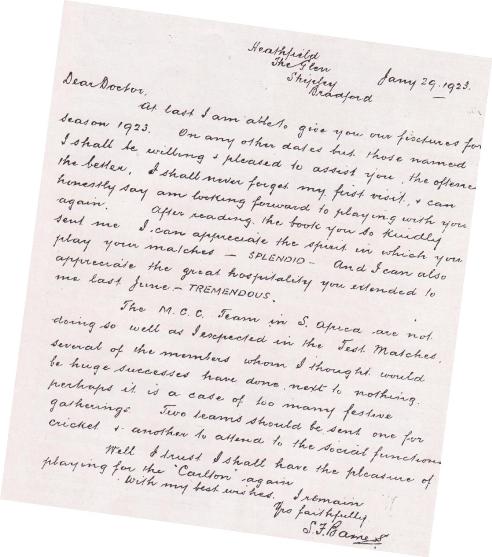

Although aged 49 in 1922, Barnes would not play his final first-class match for another eight years. His statistics as a Carlton player certainly show no signs of age having diminished his powers. In the 2 day match against a Western Union XI, Carlton won by a crushing 272 runs, with the great man returning match figures of 12 for 45.
While it would be no surprise to learn that Dr Stevenson judged his 1922 appearance as a success, Barnes himself seemed to have enjoyed the experience as he wrote to Stevenson: And he did play for Carlton again. Sydney returned to Grange Loan for two matches in 1923. In the first, against a touring team from Tynemouth, he helped Carlton to a 107 run victory, returning the rather impressive figures of 9 for 29 off his 17 overs. In his final appearance, he took the final wicket in a tight match against a Scottish Counties XI to give Carlton victory by just 16 runs. His figures were 8 for 57.
So, arguably the greatest test bowler of all time had a Carlton career bowling average of 4.5. Was he the greatest bowler ever to play for Carlton? Sydney Barnes makes a rather compelling case.
When the Aussie skipper lost three teeth to a Carlton legend
Imagine Fraser “Fraggle” Watts inviting Ricky Ponting and his mates for a night-out during an Ashes tour … and imagine the evening ending with the Aussie skipper losing three of his teeth at the hands of the Carlton man.
Well, rewind 80 years, change the personalities … and that is precisely what happened one night in Edinburgh in 1930. Legendary Carlton skipper Dr NL Stevenson relates the story in his book about the history of Carlton CC: ‘Play!’
“While the Australian team was in Edinburgh, I invited W. M. Woodfull (the captain), Alan Kippax, Victor Richardson, H. F.T. Heath and the Australian team manager to dinner.
During the meal Woodfull began to look very sorry for himself and it transpired that he had toothache. The pain became worse, and he asked me if it were possible to get some relief that night.
After a hint to Victor Richardson, I said I would go and telephone immediately. I put through a call to my own surgery and told my attendant I would be round very soon. And, to the Australian captain’s surprise, he presently found himself a patient of his erstwhile host, with his fellow diners all anxious to assist.
There were some hilarious preliminaries ; but I quickly got to business and achieved what must be a unique feat – I took three Woodfull’s “stumps” at once!”
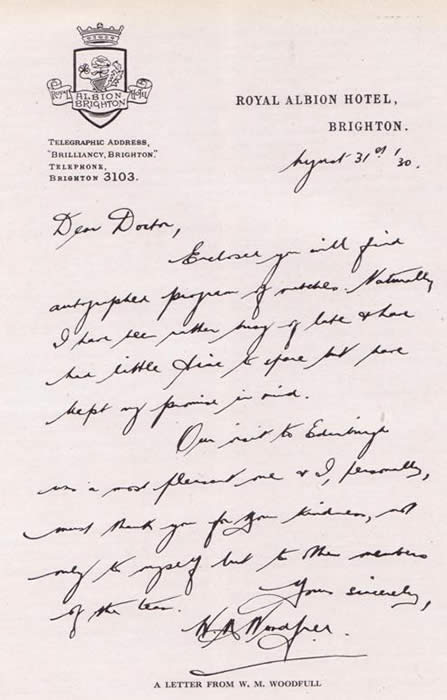
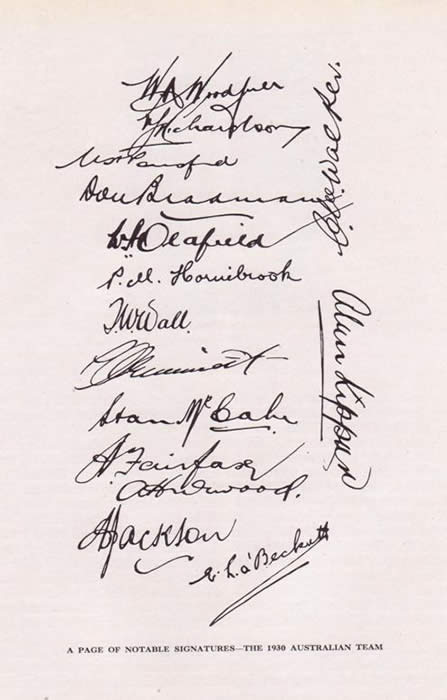
The day Carlton CC faced Heart of Midlothian FC
1936 was a successful year for Carlton. Of the 22 matches played, 10 were won and only 4 lost. It also saw the start of a highly successful opening partnership between Carlton’s “6-hitting doctor”, J.E. Phillips and the club’s Sussex-born professional Thomas Crosskey.
Dr Phillips finished the 1936 season on top of the batting averages with 60.41 with Crosskey next on 30.12.
By far the largest crowd seen at Grange Loan that season came to watch not one of the hard-fought local derbies with Grange, Watsonians or Edinburgh Academicals but a specially arranged match with Heart of Midlothian FC.

The match is thought to have been arranged with the assistance of Crosskey, who played professional football for Hearts at the time. Crosskey played for Hearts in the match and his teammates included Andy Anderson and Tommy Walker who scored 26 and 32 respectively.
Carlton escaped with a draw on the night and skipper, N.L. Stevenson, recounts the story in his book ‘Play’:
“A very interesting and enjoyable game, which attracted the biggest attendance of the season to Grange Loan, was played against a team drawn from past and present members of the Heart of Midlothian football club. To the delight of the crowd the footballers put up a very good show – a much better show, I feel safe in stating, than we should have put up, had we been invited to Tynecastle Park to meet the Hearts at their own game “
Scorecard
| Played at Grange Loan on May 20th 1936 | |||
|
Innings of Heart of Midlothian
|
|||
|
A Anderson
|
b Phillips
|
26
|
|
|
W Murray
|
c Bateman
|
b Hair
|
16
|
|
D Pratt
|
b Bateman
|
11
|
|
|
A Black
|
b Purvis
|
41
|
|
|
R D Murray
|
b Bendall
|
10
|
|
|
T Walker
|
b Stott
|
32
|
|
|
T Crosskey
|
not out
|
54
|
|
|
G Eslor
|
c Phillips
|
b Purvis
|
1
|
|
A Munro
|
c sub
|
b Scott
|
17
|
|
P Kerr, jun
|
b Purvis
|
2
|
|
|
P Kerr
|
c & b Scott
|
9
|
|
| Extras |
24
|
||
|
Total
|
(all out)
|
243
|
|
|
Innings of Carlton
|
|||
|
D J Roper
|
b Pratt
|
6
|
|
|
C D Bateman
|
st Eslor
|
b Walker
|
43
|
|
T S Purvis
|
lbw Pratt
|
18
|
|
|
E A Scott
|
b Black
|
6
|
|
|
J Hair
|
run out
|
0
|
|
|
J E Phillips
|
not out
|
26
|
|
|
A J Scott
|
c Eslor
|
b Pratt
|
6
|
|
W H Bendall
|
|||
|
F J Anderson
|
|||
|
N L Stevenson
|
|||
|
H F T Heath
|
|||
| Extras |
11
|
||
|
Total
|
(for 6 wickets)
|
116
|
|
The tragic tale of John MacFarlane
Visitors to Grange Loan with an eye for the historic can review the lists on the pavilion wall that show the names of the Carlton 1st XI captains and vice captains, together with the leading batsmen and bowlers, since the club’s inception in 1863.
The name of one young man – John Lisle Hall MacFarlane – appears three times. In 1870, the Jamaica-born Edinburgh University medical student finished the season as the club’s leading batsman and in 1871 and 1872 MacFarlane was the Carlton vice-captain.
John MacFarlane was a genuine sporting all-rounder. In his book “Play!”, Dr N L Stevenson outlines the young man’s sporting prowess:
“Dr J.L.H. MacFarlane, a brilliant short-distance runner and long jump and hurdles champion, played [rugby union] for Scotland at quarter-back, half-back and forward. He was a steady bat and one of the Club’s last regular underhand bowlers. He sent down an occasional fairly fast “grub”, and at least one of these deliveries went for a 6-bye, all run.”
 Despite his cricketing prowess, it was as a rugby player that MacFarlane earned lasting fame, playing as a forward in the first ever rugby union international between Scotland and England at Raeburn Place on 27th March 1871. More than 4000 spectators watched a match that was decided by a converted try for the Scots. Each side also scored an unconverted try apiece, but these counted for nought under the rules of the time.
Despite his cricketing prowess, it was as a rugby player that MacFarlane earned lasting fame, playing as a forward in the first ever rugby union international between Scotland and England at Raeburn Place on 27th March 1871. More than 4000 spectators watched a match that was decided by a converted try for the Scots. Each side also scored an unconverted try apiece, but these counted for nought under the rules of the time.
MacFarlane also played in internationals against England in 1872 and 1873 (a loss at the Oval and a draw at Hamilton Crescent). In early 1874, now a doctor at Edinburgh Royal Infirmary, MacFarlane was again chosen by the selectors to represent Scotland in the upcoming annual encounter with England.
However, prior to the international fixture, while playing for Edinburgh University against Royal High and shortly after kicking what proved to be the winning goal, MacFarlane fell and dislocated his knee. While such an injury would almost certainly have ruled him out of the England match, it was the delay in treatment that was to have profound implications for the young doctor as he lay on the cold ground before eventually being moved.
At his home in Buccleuch Place, MacFarlane developed a rheumatic fever, aggravated by heart and chest inflammation. After five weeks of recuperation, hopes were high that MacFarlane was over the worst. However he suffered a sudden relapse and was rushed to the Royal Infirmary, where his colleagues were unable to save him. John Lisle Hall MacFarlane died on March 17th at the tragically young age of 22.
More information: http://www.scottishsporthistory.com/uploads/3/3/6/0/3360867/rugby_tragedies.pdf
Carlton’s Olympian All-rounder
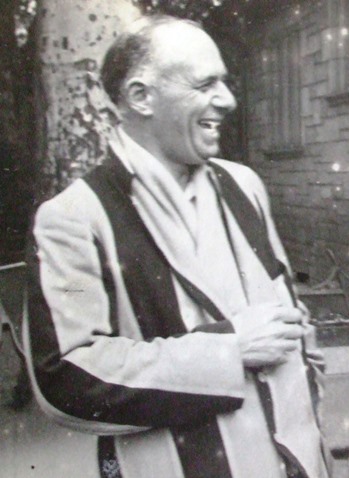 Visitors to Grange Loan may notice the picture of a particularly distinguished looking cricketer, resplendent in striped blazer, hanging on the wall of the pavilion. The gentleman in question is probably the major figure in the history of Carlton Cricket Club – Dr N.L. Stevenson.
Visitors to Grange Loan may notice the picture of a particularly distinguished looking cricketer, resplendent in striped blazer, hanging on the wall of the pavilion. The gentleman in question is probably the major figure in the history of Carlton Cricket Club – Dr N.L. Stevenson.
By any standards, Stevenson was a remarkable character. He played for Carlton from 1892 to 1948, 34 of these years as captain or vice captain, and excelled at a range of sports, including rugby (for which he trialled for Scotland), athletics and hockey. It was at this latter sport that he represented his country at the London Olympics of 1908 …
As an Edinburgh lad born and bred it would be reasonable to assume that Dr Stevenson’s Olympic adventure would have been as part of the Great Britain team. However, that wasn’t the case. It’s a strange and relatively unknown fact that Norman Lang Stevenson went to the Olympics as a member of the Scotland team.
The 1908 Olympiad was the fourth such event and had been moved to London after the originally planned hosts, Rome, had to pull out due to financial difficulties caused by the need to divert funds to aid Naples following the eruption of Mount Vesuvius in 1906. The Games in 1908 were a far cry from the commercial monstrosity we’re familiar with today. 22 nations competed in 22 sports, spread over a period of 187 days. The hockey event was the last event of all, held in late October.
Due to internal politics, the four home countries competed as separate teams at hockey – the first and only time this would happen in any sport in the Olympics. There was no trial held to select the Scottish squad; instead they were selected from a small band of clubs in Edinburgh and Glasgow. This rather relaxed approach to selection was amplified when Stevenson made a late addition to the squad as the Scots travelled south the day before their first match. As the train pulled into Hawick station, Stevenson spotted a rugby acquaintance, Ivan Laing, on the platform. Stevenson asked Laing what he was up to; when Laing indicated that he hadn’t anything special planned he was promptly invited to join the squad. This invitation was extended notwithstanding the fact that Laing had, reputedly, only ever played mixed men’s/women’s hockey.

The first game for “the Scotch” (as they were described in the official report of the Fourth Olympiad) was actually the tournament quarter final, when they defeated Germany by 4 goals to nil. There were three players from the Carlton club in the Scotland line-up for this match, Dr Stevenson being joined by H. Fraser and Captain Foulkes. If Stevenson’s last minute ‘selection’ of Laing on the platform of Hawick railway station seems the stuff of comic books, it does appear to have been yet another example of Stevenson’s sporting golden touch. The official report of the contest casually notes that: “At the beginning of the game Scotland attacked and, from a pass by Stevenson, Laing quickly scored the first goal”. Far from being a flash in the pan Laing was prominent in a number of attacks and also had an assist as Scotland ran out winners by four goals to nil.
There was to be no further success for the Scots as they were sent homeward to think again by England, who won the semi-final encounter by six goals to one. However, Carlton’s foremost all-rounder had already written another extraordinary chapter in a remarkable personal sporting history.
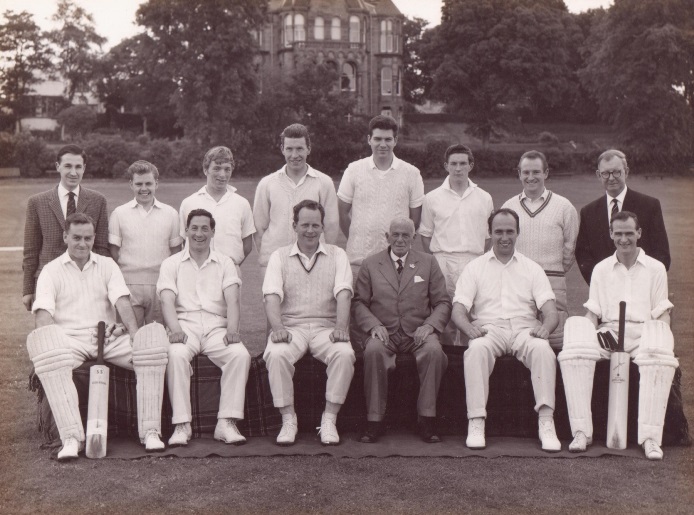
Carlton: The Early Years
Carlton’s historian DR NL Stevenson, in his history of the club published in 1945, described the first three years of Carlton’s cricketing history – from the club’s inception in 1863 to their move to Grange Loan in 1866. …
“In the early ‘60s it was the general practice in Scotland for cricket matches to begin at noon and, irrespective of both innings, play was continued till the hour agreed upon for the drawing of stumps.
Scores, on the whole, were small in club games and two-innings matches were frequently completed. A team, 60 runs of more behind on the first innings, had to follow on; but only one innings by each side was needed for a definite result.
On many grounds every hit was run out. On others a boundary counted as “3 notches”, while for a hit out of the ground the batsman was credited with either 4 runs or 5. Six runs for such hits were introduced much later.
In Edinburgh and district, at that time, there were two categories of cricket club. The upper category included the Grange, founded in 1832 and then in the “wilderness” between their tenure of Grove Street Ground and Raeburn Place, which was opened in 1872. The second grade embraced a host of Meadows and Stockbridge Park clubs [including] Carlton – the only club of them all which has survived!
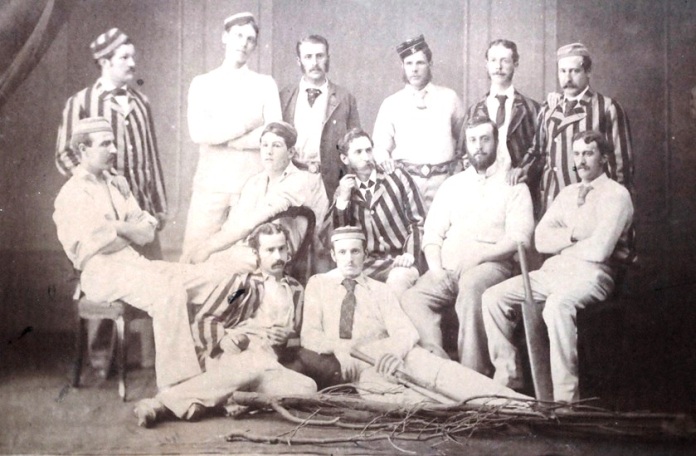
For two seasons, when the Club’s colours were “blue with white 6-inch hoops”, Carlton played almost all their matches on the Meadows. Against opponents in the matches played on the Meadows and at Stockbridge Park, the Carlton players were almost invariably successful, and this reason, with probably the additional fact that they were the only Meadows team to turn out in white flannels, led to their securing fixtures in 1865 with clubs in possession of private grounds.”
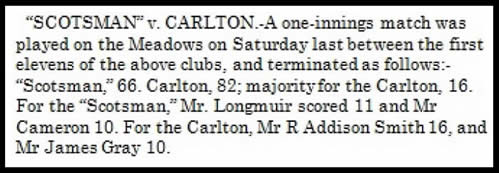
Stevenson found that the first internal record of the club’s early days came in verse form, celebrating the success of 1865. Although not in the Fantasy Bob class of poetry, it stands as an interesting record of a time long gone:
“To celebrate another year, the Carlton meet once more
With bright and happy memories of 1864.
We’ve been as busy all the year as bees within a hive,
And we’ve thrashed the best of cricket clubs in 1865″
By 1866 Carlton were playing “away” games only, and the Club considered it had reached a point that justified the securing of a private ground..
But the move to Grange Loan is another story for another day…
Carlton in the Grange
Carlton have been residents of Grange Loan (or nearby) for over 150 years …
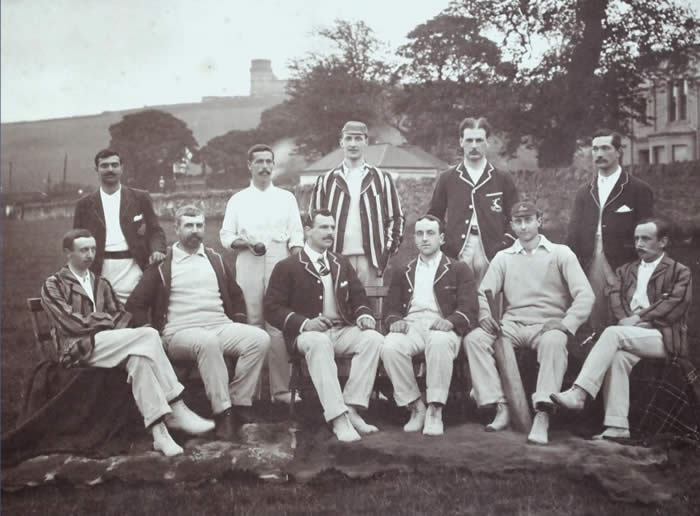
Carlton has played cricket at 180 Grange Loan – on our rather unconventional site – for over a century. But our current ground is our third home in the Grange area.
The club was founded in 1863, playing on various grounds around Edinburgh – including the Meadows (where some of our lower-league sides still play) and Stockbridge Park, close to the current home of arch-rivals, Grange. (Grange CC’s first ground was just south of Grange Loan but they subsequently moved to Stockbridge, retaining the “Grange” name and causing much confusion to this day.)
Carlton moved in the other direction in 1866, renting land just south of Grange Loan, which became known as the ‘Carlton Ground’. However, wickets were notoriously poor, so three years later, the club moved the short distance south west to “Little Transilvania” (a reference to trees/silviculture, not vampires) on the other side of St Thomas Road.

Playing conditions remained sub-standard, despite strenuous efforts over the following decades, so in time for the start of the 1905 season the club moved to the ground it occupies today – then known as ‘Grange Park’. Following a three day ‘Fancy Fair and Carnival’ organised by Secretary N.L. Stevenson, the club raised the considerable amount for the time of £1800. This money was sorely needed as the ground had formerly been used to exercise horses, and the funds were put towards clearing the land of trees, levelling and laying the square, and erecting our first cricket pavilion.
‘The Scottish referee’ reported in April 1904: “After being housed in what might be termed rather indifferent and unsuitable grounds since 1863, the Carlton have at last determined to flit, and it is satisfactory to be able to state that their new ground at Grange Park, which is within a few minutes’ walk of the old field, is one of the finest in the district. The turf is hardly fit for this season’s work, but by another year it should be in grand order.”
And indeed the new ground was opened on May 17 1905, when Carlton hosted West of Scotland.
As the Grange area was extensively built-up in the latter half of the 19th Century, firstly with town houses, then more recently with higher-density flats, our old grounds have been built-over. However, Carlton happily remain at our unique current home – a haven for cricket and an amenity for residents in the local area to enjoy.
Women’s cricket – 1923 style
One of the most successful transformations seen at Grange Loan in the 21st Century has been the introduction of the Carlton women’s side. The girls’ and women’s section has proved a positive influence throughout the club, both on and off the field, but a scan through the club archives suggests that women’s cricket at Grange Loan is nothing new. Here’s an extract from a report of an unusual match from 1923. We’d like to think that not all of the writer’s observations on women would make it past the Carlton website editor today!
Ladies’ Match
A midweek game of a rather unusual kind was played at Grange Loan on the afternoon of 2nd July when we engaged in an encounter with the young ladies of Craigmount School, who practise cricket on our ground during the summer. Everyone knows that members of the fair sex are taking up nowadays, with marked success, various spheres of endeavour which were formerly considered masculine preserves and, judging by this game, the ladies will very soon have to be taken seriously on the cricket field.
Ladies’ cricket matches! The thought opens up a wide field for speculation and suggests infinite possibilities of this “brighter cricket” about which so much nonsense is talked nowadays. Dwell on the idea for a moment. Imagine Lords or the Oval, as the scene of a match between the ladies of England and Australia or France! Picture the different charming costumes worn by the fair exponents and the discussion in the pavilion on the colour-scheme of the latest fashionable attire from Paris. And would this absorbing discussion cease during the course of the match? Or would “talked out” become one of the methods of dismissing opponents?
What of the umpires too? Could any man be trusted to steel his heart and give impartial decisions? A winsome smile or an appealing look would bring about more bad lbw decisions than the most frenzied “How’s That?” of today! One can easily picture these, and many other, fascinating scenes, but the imagination reels before the thought of what our present-day bugbear, the Tea Interval, would become under the new conditions!

However, these pictures have nothing to do with the Craigmount School ladies, so let us leave the alluring realms of fancy and return to Grange Loan and cricket. This afternoon match proved most interesting and successful in every way, and not the least enjoyable part of the programme was the tea kindly provided by Mrs Kyd for the players and spectators.
The cricketing ability shown by our opponents was very promising indeed and the school coach may well feel gratified at the successful results already achieved. The batsmen (or should it be batswomen?) punished our left-handed attack in light-hearted manner, and several of them made runs all round the wicket in very good style.
Miss Boath, Miss Panton, Miss Marsden and Miss Ingles all batted well – some of their strokes being really first-class – and altogether the whole side gave a most promising display. The bowling, too, was wonderfully accurate for ladies, and the work of the side in the field reached a very high standard indeed. Pavilion critics were all agreed that it was a most unusual treat to see keenness and enthusiasm in the field at Grange Loan, and the hope was freely expressed that certain lethargic members of our 1st XI would profit by the ladies’ example in this respect.
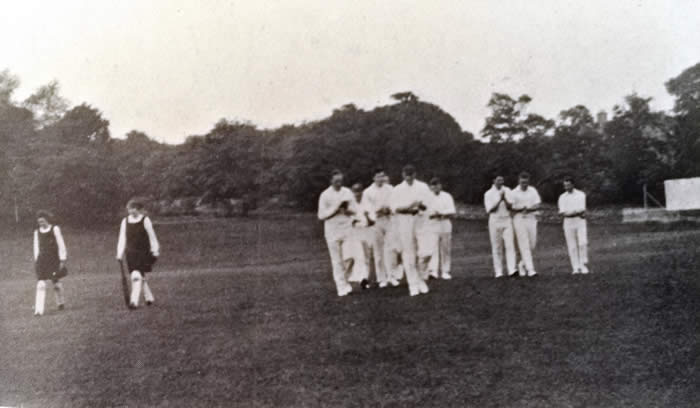
By way of saving their self-respect our players batted left-handed, and the feature of our innings was a really fine knock by Mr J. G. Kyd, who played so well that doubts were expressed as to his really being a right-handed batsman! Mr Kyd’s splendid display was duly noted for future reference, and we are looking forward to his appearance next season in more serious contests.
The Grand Fancy Fair & Carnival 1912
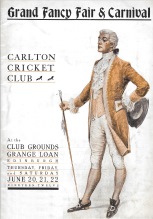
Despite having a home in one of the leafiest suburbs in Edinburgh, Carlton Cricket Club has always led something of a hand to mouth financial existence. Back in 1912, the £100 raised by inviting WG Grace to come to Edinburgh 30 years earlier had long been spent and the club decided to mark their 50th anniversary with an event that would “raise Funds to improve the Ground and carry on the Club in such a way as its reputation deserves”.
In holding the splendidly named Grand Fancy Fair and Carnival the club was looking to repeat the success of its first Fancy Fair and Carnival in 1904. At that point Carlton had just taken over the use of ‘Grange Park’ (our current ground) and the event was a success to the extent that “sufficient money was raised to build a Pavilion and lay out the ground for cricket”.
The 1912 fair was held over three days in June and was on a scale that seems remarkable to modern eyes. Thankfully a programme has survived for the event and it makes for fascinating reading.

The band of the Black Watch played at Grange Loan (hopefully they didn’t march across the square) and there was a“Musical and Dramatical Pavilion … under the direction of Madame de Grenier”.
A range of stalls was laid out to entertain the great and good, including a Sweet Stall, a Flower Stall, a Tobacco and Pottery Stall, a Toy Stall and a Photographic Stall. Mini golf and a golf clock were available, while patrons were also entertained by a Palmist, Madame Van Bien, on what was described as “positively her last engagement in Edinburgh before her round the world tour”. Perhaps the Carlton Fair was such a prestigious engagement that Madame Van Bien delayed her world tour and so missed travelling to New York on the SS Titanic just 10 weeks earlier?
With over a hundred years’ worth of hindsight, the adverts in the programme are particularly entertaining. A pair of leather-lined white buckskin cricket boots can be yours for just 10/6 (52.5p) from Baird the Bootmaker. Alternatively, if indoor pursuits are more your style, you can have “hours of real joy and pleasure” by purchasing an autopiano from R W Pentland of Frederick Street.
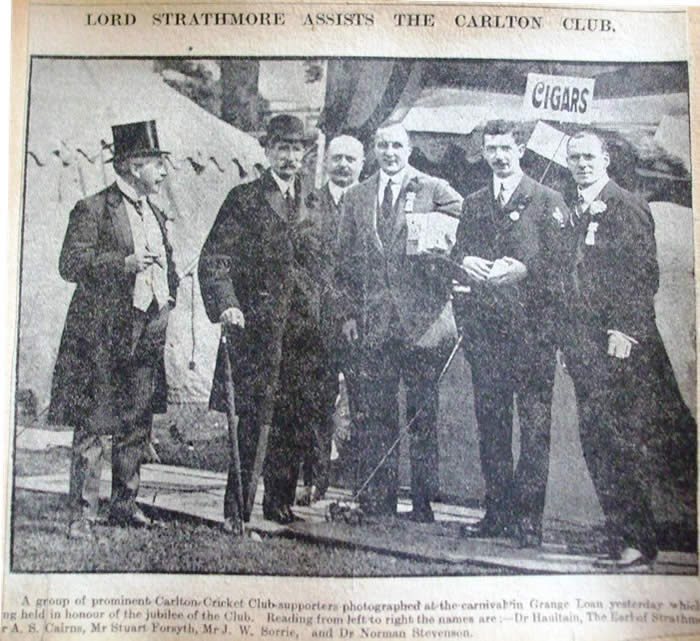
There’s also a suggestion that the Scottish summer weather hasn’t changed much in a century as Thornton & Co are offering waterproof garments “that are really waterproof”, while McNabs the “renowned” dry cleaners of Slateford offer “special terms to approved clubs for the cleaning of athletic attire”.
By contrast, we can see that the social standing of the Carlton faithful might have fallen somewhat since 1912, with Scots’ Porage Oats – who clearly knew their audience – advertising that their new-fangled method of making porridge in just 5 minutes means that “the maid” can get an extra 30 minutes in bed every day.
So much has changed since that summer weekend in 1912, but we hope that all those volunteers who put so much effort into the large-scale fundraising venture back then would be pleased to see the old club still going strong at Grange Loan well into the 21st century.
See the 1912 Carlton Grand Fancy Fair and Carnival programme
RIP Carlton (1863 to 1871)
The oldest surviving object in the archives of Carlton Cricket Club is a dark, leather-bound journal with yellowing pages. The inside cover contains copperplate script in fading ink:

While, sadly, Volume 1 doesn’t appear to have survived since Carlton’s inception in 1863, the second volume provides some fascinating insights into the very early years of the club. At that time Carlton rented a ground just off Blackford Avenue and the meticulously handwritten pages document the ins and outs of the club almost 150 years ago. While much of the business relates to the non-glamorous aspects of running a cricket club, and will be familiar to modern committees everywhere, there are some gems that tell of a bygone era.
For example, one entry in 1871 records that the club was keen to embrace technology to improve club communications. “The chairman moved, seconded by Mr Brownlie, that the Club should get a Telegraph as it was a real necessity. After some discussion Mr C Moxon was appointed to find out the probable cost and report.”.
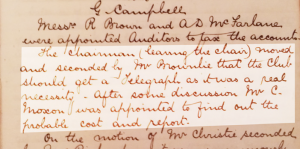
And there was no lack of ambition at Carlton, with one meeting resolving to invite the “United South of England Eleven” to Edinburgh for a fund raising match and it was agreed that “a committee should be formed make up a List of Twenty Two Gentleman to play against the Eleven.” (This initiative proved successful with none other than WG Grace appearing for the touring team in the two day match in May 1872.)
However, despite the success of this ambitious initiative, there were soon clear signs that all was not well at Carlton.
The minutes of the October 1872 committee meeting evidence the first signs of trouble. It seems that the club had felt the need to approach the honorary president Mr Blyth “asking if he felt inclined to give any donation to the funds of the Club.” Mr Blyth, it appears, was not impressed, replying “I imagined that the Carlton Club would have been in funds this year” and tendering his resignation. As the minute book puts it: “The President also stated that he had now made up his mind to retire from that office and requesting that his name be struck off the list.”

This seems to have been too much for the meeting and the record includes the following ominous paragraph: “Some conversation now took place as to the propriety of carrying on the Club for another year and it was agreed that a General Meeting of the Club should be called to consider so important a question.”
So it was that on 19th November 1872, a Special General Meeting was held in the Ship Hotel for one crucial bit of business. The notes record that “The chairman then stated that the object of this meeting was to consider whether the Carlton Cricket Club could be carried on for another season with any chance of success.”
We can only assume that the minute-taker was unimpressed by the quality of the debate as the minutes show: “After a great deal of desultory conversation, Mr Christie moved that the Carlton Cricket Club as at present existing should not be carried on for another season.”
What followed was possibly the most important moment in the club’s history. However, the outcome is recorded only in the most understated terms: “Some discussion followed upon this motion and it being evident that the Club should be carried on Mr Christie withdrew his motion.”

Successive generations have, of course, had every reason to be grateful for that decision. The minutes of what could have been the last ever meeting of Carlton Cricket Club then end with the standard notation of the time:
“There being no other business the meeting dissolved.”
